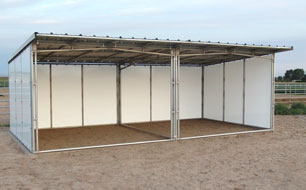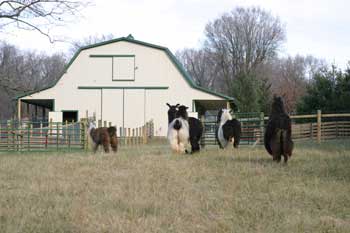(Note: ALSA is the Alpaca Llama Show Association, the national organization for consistency and tracking of llama & alpaca shows. They are one of the primary promoters for llamas, and provide the consistent basis for show standards that promote the breeding and training of fine llamas. ALSA’s contributions to llamas is indisputable. This article is meant for entertainment purposes only, although serious responses from ALSA judges and show organizers is encouraged.)
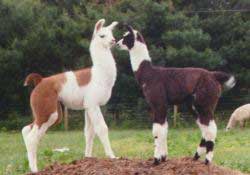
Buster and Snapshot Kissing
Buster, on the right, at two weeks old, with all his original legs!
While many of our other llamas have attended llama shows throughout the region, we have yet to take Buster. Buster is a friendly, well-mannered three year old gelding who goes to many functions with us, such as visits to kids homes, and entertains disabled visitors as well as family, friends, and school children here on the farm. Everyone who meets Buster remembers him, and many have received one of his warm, special “llama hugs” for which he is famous. Despite his easy handleability and calm nature however, he has never had a chance to compete in a show. Buster, you see, only has three legs.
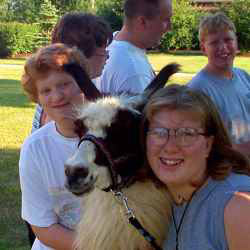
Buster Visiting with Kids at Damar
We have longed to take Buster to a show, and demonstrated what a real “public relations” llama can do. Despite his disability, and maybe even because of it, he fills this role perfectly. Many disabled children see Buster’s courage, and are inspired; as are almost all who see him. He runs and plays with the other “boys,” hops in the trailer, balances for toe nail trims and can even teeter-totter on his two front legs to scratch his belly with one back foot! But taking a three-legged llama to a competitive show? This has seemed a little too much. Buster at the Damar center; he is the best PR llama ever!
We have tried to consider how we could do this, and decided that the problem was the “competition” of the show ring. Of course showing is competitive; but llamas are also just plain fun, and a joy to be around. No one demonstrates this more than Buster, who always will give me a special hug when I need one. Maybe if we enter him in a non-competitive nature, we could just have fun and share this unique fellow with everyone. Just for fun, we thought we would explore how ALSA show venues might accommodate a llama with disabilities.
PR Obstacle course: the obvious choice for Buster, as this course is designed to demonstrate a llama’s ability to cope with typically man-made “obstacles” that he might encounter at a school, nursing home, etc. While llamas are generally not asked to jump large hurdles in this course, occasionally a jumping hazard is included. We have had Buster jump small hurdles, but would prefer to let him walk or hop over such an obstacle, to save unnecessary stress on joints and tendons. Steps are difficult, but doable. Also backing up steps, a popular obstacle in the more advanced classes, is more of a challenge for Buster, but perhaps he could just take the faults on these, and be there to participate and enjoy, not compete for prizes. His prize is what he gives to others, not whether he can negotiate every imaginable obstacle. My main objective would be that Buster is judged fairly. We wouldn’t want him to place because of a “sympathy vote,” but at the same time, the obstacles are by and large more difficult for him to negotiate too. How would a judge handle this? Perhaps we could not compete at all, but simply do a demonstration after the class? Or are there enough “special” llamas out there that they could have a class of their own someday? Sort of a “Special Olympics” for llamas!
Halter class, non-breeding llama: Now here is a good one! A non-breeder halter class has always been a contraction to me. Llamas are altered (gelded or spayed, or otherwise prevented from breeding) because of one or more characteristics that render them less desirable for breeding. These could be conformational flaws, or something as inconsequential to the animal’s fitness as the amount, quality, or placement of the wool. In fact, non-breeder classes lump all wool classes together, so that short-wooled llamas, the type often gelded by long-wool breeders, are judged side by side with long, flowing wool beauties. To then compare and grade animals that have been previously determined to be flawed, seems strange indeed, especially considering preferences for wool type. Most animals even with poor conformation, short necks, or poor setting of the ears or tail can lead long, prosperous lives. They just do not carry the traits that are considered desireable for the breed. It would seem that this venue might encourage people to geld a near-perfect stud animal, thereby being assured of taking the awards in this class. A large farm with a lot of profit potential can afford to sacrifice such a llama for this purpose, and certainly there is a case for abuse of what this class is intended to be. I do not believe this practice is common, and would certainly be frowned upon by most breeders with a sense of fair play. Since a precedent in other animal shows also has been set for “pet” classes, I suppose one needs to just go along with the judging criteria. The judge does evaluate the llama on handleability and calmness to some degree, often petting the llama or asking the owner to lift its feet. A llama of excellent conformation however will rarely loose more than one placing in the final standing for failure to be handled easily.
Now how does Buster fit in to this? Certainly he is handleable, and has three very straight legs, and nice features such as ears, balance, and quality wool that would have perhaps made him a stud prospect for someone. His size and bone structure are smaller than either his sire or dam, leading me to believe that his early injury and trauma may have affected his growth. But how do you judge a llama on movement when he hobbles about on three legs? How would the judge handle this? Any judges out there care to comment? What would YOU do if I entered Buster in your class?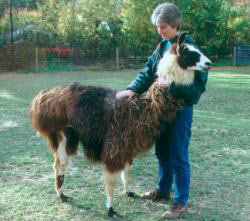
Fun stuff: At most shows there are some fun classes, that are not ALSA sanctioned, but are designed to challenge the owner and llama and entertain the crowds. Perhaps some of these would be places that Buster can show off!
buster_497.jpg (14290 bytes)
Buster at one year old, enjoying a good scratch.
Limping Llama contest; This is a variation of the Leaping Llama contest, where llamas are required to leap a hurdle of ever increasing height, until all the llamas have been eliminated except one, the winner! Now Buster cannot jump high buildings with a single bound, so we need a Limping Llama contest, where he would be a sure-fire winner!
Orgling contest: In this venue, people, not llamas, compete to see who can imitate the llama’s orgle, the sound made when male llamas are engaged in amorous pursuits. Buster, however, can orgle on command. We discovered this quite by accident. He was scratching his belly with his one rear foot, balanced with head down on his two front feet. We wondered if he could get in a “good scratch” that way, and endeavored to scratch all the areas underneath his chest and belly that he could not reach himself. He really enjoyed this, and soon began making orgling sounds! When you stop scratching him, he looks at you as though to ask you not to stop! After a good hug, he always gets a nice belly scratch, for which he emits a few appreciative orgles. Now if we can get him to orgle the Star Spangled Banner, like last year’s winner at the Indiana State Fair, we’d have this class licked! Click here to hear Buster!
Costume class: We can get a little crazy here! Of course, that is what everyone does! The peg-leg pirate, the 6 Million Dollar Llama, what suggestions do you have?

